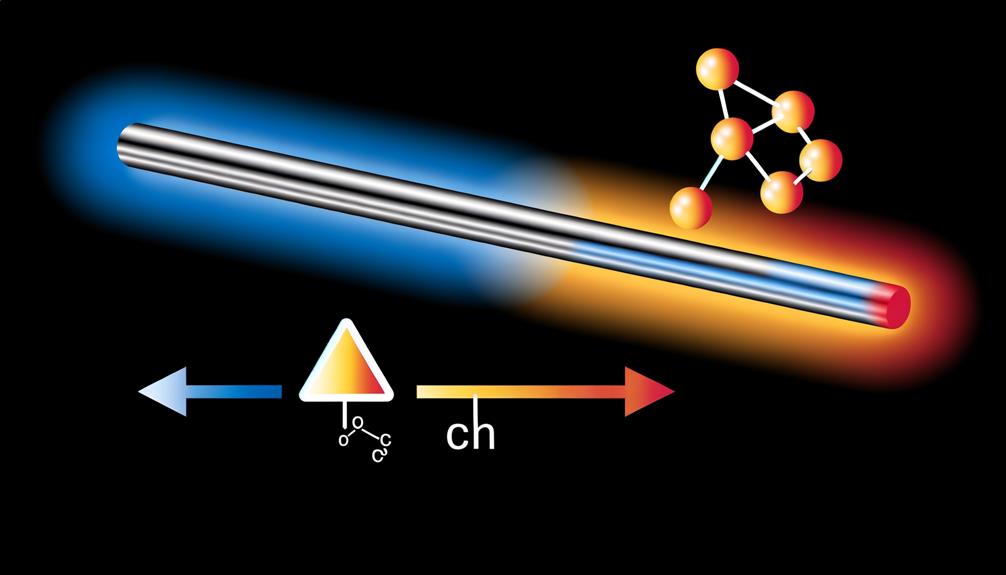Triangle Symbol Meaning in Physics?
In physics, the triangle symbol (\(\Delta\)) signifies a change or difference in a specific physical quantity. For instance, \(\Delta v\) indicates a change in velocity, essential for kinematic analysis.
\(\Delta E\) represents a difference in energy, necessary for understanding energy transformations in thermodynamics and quantum mechanics. \(\Delta T\) denotes a variation in temperature, important for thermal dynamics and heat calculations.
\(\Delta x\) quantifies the displacement in motion, providing insights into distance and direction. Additionally, \(\Delta p\) marks a change in momentum, critical for dynamic system analysis.
These interpretations underline key principles in physical science; further exploration reveals their broader applications.

Key Takeaways
- The triangle symbol (\(\Delta\)) represents change or difference in physical quantities.
- \(\Delta v\) signifies the change in velocity, essential for calculating acceleration.
- \(\Delta E\) denotes the difference in energy, crucial for energy transformation analysis.
- \(\Delta T\) indicates temperature variation, important for heat transfer calculations.
- \(\Delta x\) represents displacement, providing vector change in position in kinematics.
Change in Velocity

In physics, the triangle symbol (Δ) is commonly used to denote a change in velocity, representing the difference between the final and initial velocities of an object. This concept is fundamental in kinematics, where velocity changes are analyzed to understand motion dynamics.
Mathematically, the change in velocity (Δv) is expressed as Δv = v_f – v_i, where v_f is the final velocity and v_i is the initial velocity. This calculation is essential for determining acceleration, which is the rate of change of velocity over time.
Difference in Energy
Building on the concept of change, the triangle symbol (Δ) is also pivotal in representing the difference in energy (ΔE) within various physical systems.
ΔE quantifies the energy shift from one state to another, essential in thermodynamics, quantum mechanics, and classical mechanics.
For instance, in thermodynamics, ΔE might denote the alteration in internal energy due to heat transfer or work done.
In quantum mechanics, ΔE represents the energy variance between quantized energy levels.
This symbol's usage facilitates precise mathematical formulations, enabling clear communication of energy transformations.
Understanding ΔE is essential for analyzing reactions, processes, and interactions, providing insights into system behavior and energy conservation principles.
Variation in Temperature

Variation in temperature, denoted by the triangle symbol (ΔT), is fundamental in understanding thermal dynamics and heat transfer within physical systems. This parameter signifies the change in temperature between two states or points in time and is pivotal for evaluating energy exchange processes. ΔT is essential for calculating heat (\(Q\)) using the formula \(Q = mcΔT\), where \(m\) is mass, \(c\) is specific heat capacity. The following table illustrates key factors influencing ΔT:
| Factor | Description |
|---|---|
| Mass (\(m\)) | Quantity of matter in the system |
| Specific Heat (\(c\)) | Material's capacity to absorb heat |
| Initial Temp (\(T_i\)) | Starting temperature |
| Final Temp (\(T_f\)) | Ending temperature |
Understanding these variables enables precise thermal management and energy efficiency in various applications.
Displacement in Motion
Displacement in motion, symbolized by the triangle (\(\Delta\)) followed by position (\(x\)), quantifies the vector change in an object's position from its initial to final point. This parameter is pivotal in describing motion as it provides information not just about the distance traveled, but the direction as well.
Mathematically, displacement (\(\Delta x\)) is expressed as:
\[
\Delta x = x_f – x_i
\]
where \(x_f\) is the final position and \(x_i\) is the initial position.
Unlike distance, which is a scalar quantity, displacement is a vector, incorporating both magnitude and direction. This distinction is vital in fields such as kinematics, where understanding the complete nature of an object's motion is fundamental to further analysis and applications.
Shift in Momentum

Understanding displacement is essential, as it directly influences the calculation of momentum, a vector quantity reflecting an object's mass and velocity. The shift in momentum, denoted by the Greek letter Δ (delta), signifies a change in an object's momentum and is vital in analyzing dynamic systems.
Key factors influencing the shift in momentum include:
- Force exerted: The magnitude and direction of the applied force.
- Time duration: The length of time over which the force is applied.
- Mass of the object: Heavier objects require more force to achieve the same Δ in momentum.
- Initial velocity: The starting speed and direction of the object.
Conclusion
In summation, the triangle symbol, Δ, serves as a quintessential notational tool in physics, representing the concept of change across various domains: velocity, energy, temperature, displacement, and momentum.
This symbol, reminiscent of Heraclitus' assertion that 'change is the only constant,' encapsulates the dynamic nature of physical phenomena.
Its application underscores the pivotal role of variation in understanding and quantifying the intricacies of the natural world, thereby facilitating a deeper comprehension of fundamental physical principles.





